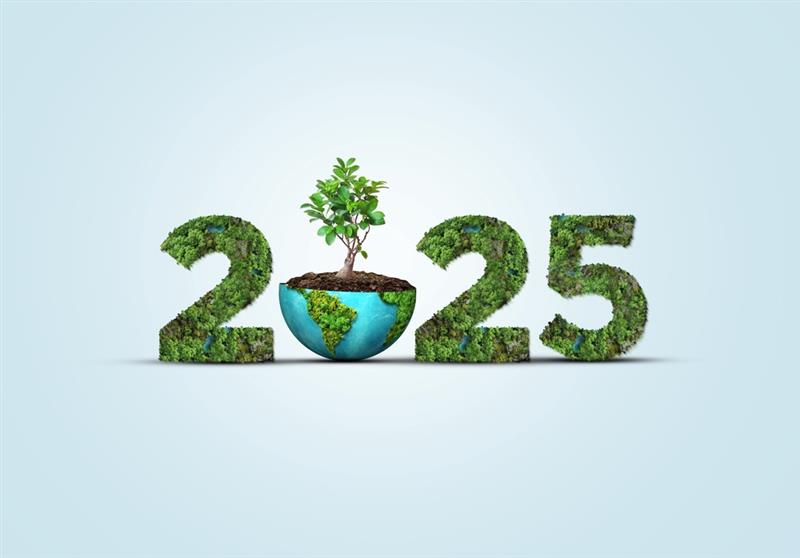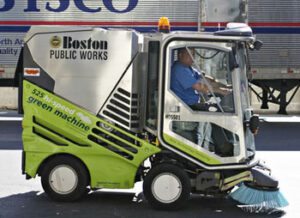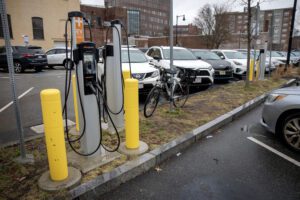Twelve Ideas for Eco-Friendly New Year’s Resolutions

From Michael McCord, Chair of NABB’s Green Committee
None of us is ever alone when we chose to take a new eco-friendly step. Others are already doing the same, and, eventually, as more people join in –and as each of us gets better at caring for the Earth– our collective actions begin to have huge impacts.
Here are a few things that some of your neighbors in the Back Bay are already doing—maybe you as well. If not, consider joining them:
1. Reducing Waste Material: We will never ‘recycle’ our way out of the massive amounts of waste that we are currently producing, so being more mindful of what we purchase (Thinking, perhaps, about needs vs. wants) and also repairing and reusing the things we need will most certainly help the environment.
The old fashion ‘needle and thread’ solution can increase the life of fabrics. And for the mechanical things in our lives, there are excellent on-line resources to help anyone with a screwdriver and wrench do simple repairs (even of appliances!) ‘Previously owned’ replacement parts (or the whole object that isn’t functioning correctly) can also be found on line—and given a ‘second life.’
Eventually, of course, some things cannot be repaired and need to be disposed of. If we, however, slow the rate and the amount of waste being dumped into landfills—and slow our purchasing rate of ‘things’ in general, we will also slow down the production of Green House Gas (GHG) emissions associated with manufacturing new ‘things’ and reduce the eventual costs of disposal. For more info, google: “Waste Reduction.”
2. Reducing Food Waste: Food waste accounts for “about half of the greenhouse gas emissions from the global food system, including methane emissions from food waste deposited in landfills.” It is also estimated that the average American family of four spends $1500 annually on food left uneaten. If we better plan our meals and take inventory before shopping, we can reduce food waste, reduce GHG emissions, and save money. For more info, google: “Food Waste Reduction.”
3. Composting: For buildings up to six units, Boston will provide no-cost, heavy duty plastic bins for weekly ‘pick-up’ and small under the kitchen counter containers (with bags) for daily use. The bins are roughly 14 inches square and about 24 inches tall. They have tight sealing lids and wheels and they can hold the compost of 2-3 families—depending. If the bins cannot be stored in a building’s basement, they perhaps can be tucked in the corner of the building’s alley parking lot. For more info, google: “Boston Composting.”
4. Support the Greening of the Electric Grid: If you are not a member of the cost-saving city sponsored electricity purchasing program called “Boston Community Choice Electricity,” (BCCE) consider joining. For more info: google the full program name.
It will save you money and add more green electricity to the grid than is added by our local utility company.
If you haven’t upgraded to Green 100 (the ‘greenest’ option’ in BCCE) and can afford to do so (depending on your usage, it costs a few more dollars monthly), do that upgrade ASAP on the BCCE website. It’s easy and you can make the change in a minute or two.
5. Reduce your use of plastics: Admittedly, this is hard because so much of what we buy is packaged in single-use plastic, but imagine the impact on the earth—and on the plastic industry—if we could collectively reduce plastic usage by 5% a year, instead of fueling the 40% projected increase in plastic production over the next decade. ‘Send a message’ to the plastic industry that: we know they are harming the health of people near their manufacturing plants; we know they are leaching micro-plastics into our earth, our water supplies, our oceans—and our bodies; we know that most (c. 91%) of the plastic that they produced is not recycled; and we know we want less single use plastic rather than more. For additional info: google ‘plastic reduction.’
Things we can do right now: Start by thinking about ways you might reduce the consumption of single use plastics in your own life: Store left-overs in glass containers or aluminum foil instead of plastic wrap. Take your own containers with you to bring home left-overs from a restaurant meal. Use sturdy reusable bags for shopping; use mesh bags for fruits and vegetables; and while it seems to get harder by the week, to find items you need in the grocery store sold in glass or metal containers–or unwrapped, look for them. Lettuces, for example, can still be bought at most stores off the shelf, rather than as ‘mixed greens’ in a clamshell box. Mix your own (as we all did–not so long ago), save money, and reduce plastic waste.
6. Insulate your windows: Whether you are a renter or a homeowner, you can increase your comfort and reduce heat loss or, in the summer, AC loss, by sealing around windows—and doors. Most anyone can do this at minimal expense with weather stripping that lasts for many seasons. Google “Insulating windows” for more info.
7. Recharging Groundwater: The Back Bay has two interrelated problems—to which we offer a partial solution: #1. Our buildings are built on marshland and the wood pilings holding our foundations rot if they are not perpetually covered with water. #2 We have a combined sewer system (it carries both waste from buildings and rainwater in the streets) and sometimes this mix backs up and discharges raw sewage into building basements (if they don’t have ‘back flow valves). More frequently, in heavy rains, the overflow mix of rainwater and sewage dumps into the Charles River.
A partial solution to the latter problem would involve you using your skills of inquiry and possible persuasion to get the ‘owner’ or ‘owners’ of your building, to recharge the rainwater coming down the front side of your building into the front yard, instead of into the overtaxed sewers. For more info on how this can be done rather easily, contact: Green@NABBonline.org
8. Make your own seltzer water: Much less expensive than buying seltzer in single use plastic bottles, easier than lugging heavy bottles home from the grocery store, and certainly better for the environment. And you can flavor your home-made seltzer to suit your tastes. Most hardware stores sell these ‘at-home’ devices and also provide the seltzer canisters which, after they run out of CO-2, you can swap out for a refill.
9. Walk more and use public transit when possible instead of driving: We live in a ‘walkable city’ and our once decrepit transit system has undergone massive improvement. Give it a try if you haven’t been on it for a while. Get a senior pass if you qualify, and ride for half fare.
10. Eat more sustainably: When possible, buy locally to avoid the environmental transit and refrigeration ‘costs;’ try to eat less meat which has high GHG impacts in its farming and processing.
11. Limit air travel as much as feasible: Sometimes air travel is unavoidable, but be mindful that it still has high GHG impacts, even with some recent advances in ‘cleaner’ aviation fuel.
12. Consider divesting from financial institutions backing fossil fuel expansion. Despite the high profitability and availability of fossil fuels, we need to methodically move away from their use because of Global Warming—and not be expanding their production.
Related Articles
The City’s Daytime Neighborhood Street Cleaning program currently runs from April 1 through November 30.



